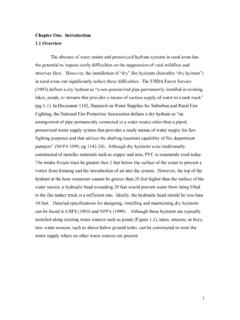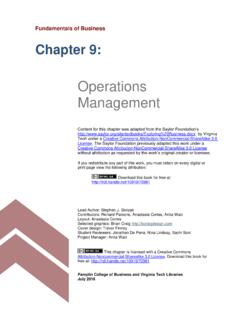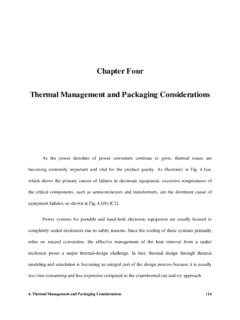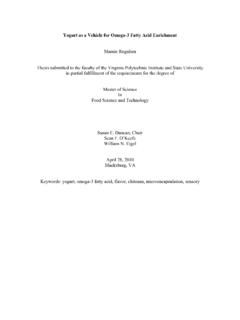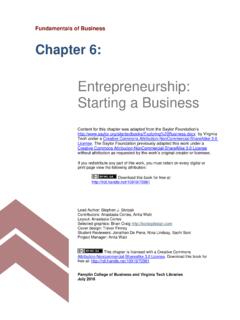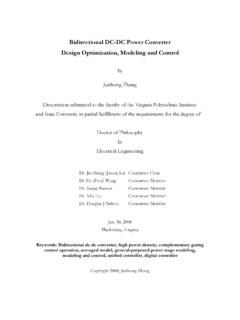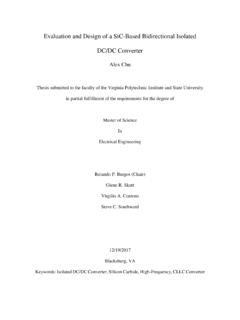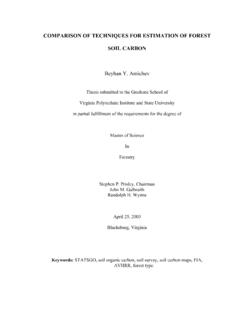Transcription of Chapter 1. Introduction - Virginia Tech
1 Bo Yang Chapter 1. Introduction 1 chapter 1. Introduction Background and Objectives With fast advance in very large-scale integrated circuit (VLSI) technology, more and more transistors can be integrated into smaller silicon chips. As a result, more powerful, compact digital systems are becoming available. At the same time, these exciting changes in VLSI also imposed exciting challenges on power management for these digital systems. The challenges come from several aspects of changes in digital system. First, as more and more transistors are integrated into the integrated circuit chip, the power required to operate the chip is increasing very rapid.
2 Second, with the transistors working at higher frequency, the supply voltage is reducing with fast transient speed and tight regulation requirement. Third, as VLSI technology is moving very fast, the power management requirement is becoming a fast moving target. Distribute power system (DPS) as shown in Figure , is been widely used for server and telecom power systems which represents the most advanced digital systems. In a distributed power system, power is processed by two stages. First stage converts AC input to 48V intermediate DC bus. This DC voltage is then distributed to the load side. The load converter, which is located on the load side, Bo Yang Chapter 1.
3 Introduction 2processes the power second time by converting DC distribution bus to whatever voltage needed by the load. Figure Distributed power system structure Many advantages of distributed power system prompted its use in these applications. First, with fast dropping on supply voltage of digital system, it is not realistic to delivery the power with such low voltage. DPS uses much high voltage to distribute power. This greatly reduces the loss associated with power distribution. Second, since the second stage (load converter) is placed very close to the load. The impact of parasitic is minimized. This converter can have very fast transient response to provide the fast current slew rate to the load. Third, for a distributed power system, front-end converter is independent of the load requirement.
4 Each load converter is also independent to other load. This provides significant benefit for the fast changing system requirement. With distributed power system, when technology changes, only the load converter associated with that load need to be redesigned, the impact on whole system is minimized. Bo Yang Chapter 1. Introduction 3 Beside these aspects, DPS also provides other benefits. First, DPS is an open architecture, modularized solution. The power system can be reconfigured as load system been expended or upgraded. It is a system which can grow as needed. Second, with modularized design, high reliability can be achieved with N+1 redundancy [A7].
5 Because of these advantages of DPS, it is been widely adopted for different applications [A4][A5][A6][A8]. DPS is been adopted exclusively in high end sever system and telecommunication system. Even for the most cost sensitive application like Personal Computer, DPS concept is been partly adopted. For today's personal computer, a hybrid power system is used. For critical components like CPU and Video Adapter, the distributed power system concept is used. For less critical components like modem-card or network-card, it still use centralized power system structure. With increased clock speed, very soon the memory will also have dedicated power supply. More DPS structure could be expected. Although for DPS, the front-end converter is not so closely related to the load, still other aspects of the load requirement imposes lot of new challenges to the front-end converter.
6 The major impacts come from following aspects. First, as integration level increases with surprising speed, more and more transistors are integrated to the system with faster switching frequency. The digital system is becoming more and more power hungry and compact. As a supporting subsystem, Bo Yang Chapter 1. Introduction 4people tend to give fewer budgets for the power supply system. So the requirement for the power system is to provide higher power with smaller volume. Another significant difference, which is driving the industry, is the profile. For the digital system, all the components now can be build with very low profile.
7 So people expect to build the system with low profile too. With lower profile, more computational power could be build into smaller rack; this will reduce the system and maintains cost. This calls for a power supply to have compatible profile with digital components. Traditional systems normally have a profile of to 2U (1U= ), now the industry is moving toward 1U power system. These trends could be observed in Figure , Figure and Figure In Figure [A1], the trend for computer server system power requirement is shown. For high-end server system, the power level will increase by factor of 6 in recent 5 years. (From IBM Power Technology Symposium 2002, by Dr. Thai Q. Ngo, IBM) Figure Trend for server system power level Bo Yang Chapter 1.
8 Introduction 5In Figure [A1], the trends for power density, efficiency and lifetime are shown. Within next several years, the power density needs to increase by a factor of 2. Efficiency needs to increase by more than 5%. To achieve this efficiency improvement, 30 to 50% reduction of system loss is required. (From IBM Power Technology Symposium 2002, by Dr. Thai Q. Ngo, IBM) Figure Trend for AC/DC power supply for server In Figure [A1], the need for 1U system is showed for 2000 and 2001. As seen in the picture, within one years time, the need for 1U system doubled. As for now, more and more server system are built with 1U profile as can be seen in all the major server manufactures like DELL, APPLE, GATEWAY etc. (From IBM Power Technology Symposium 2002, by Anthony Stratakos, Volterra) Figure Trend toward lower profile system Bo Yang Chapter 1.
9 Introduction 6 From above discussions, we can see that the trends for front-end system are strongly affected by the digital system evolutions. The power density is expected to double. Loss is expected to reduce by more than 30%. And profile is expected to reduce by 50%. Next the state of the art technology will be reviewed and paths to achieve these goals will be discussed. State of the art topologies Inside front-end converter, two-stage approach is widely adopted as shown in Figure With two-stage approach, there are two power conversion stages inside the front-end converter. First stage converts AC input to a loosely regulated 400V intermediate DC bus with power factor correction. Second stage, front-end DC/DC converter, will convert 400V DC into a tightly regulated 48V DC bus, which will be distributed to the load converter.
10 For a single-phase system, 1kW system is the most popular power level because of its flexibility for 2 to 3 kW system. Also, at this power level, the choice of power devices is around the optimal. Figure Two stage structure of front-end converter In this dissertation, the design challenges, issues and solutions for the second stage Front-end DC/DC converter in a 1kW system will be discussed. Bo Yang Chapter 1. Introduction 7 Most front-end DC/DC converter designs evolve around full-bridge, two-switch forward, and half-bridge converters, as shown in Figure Among the possibilities and for the power level under consideration (1 kW), half-bridge converter and full bridge converter provide the best combination of simple structure, low device stress and soft switching capability.
